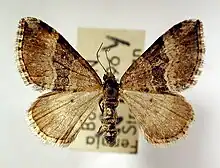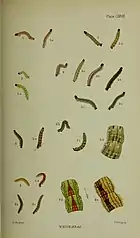| Barred rivulet | |
|---|---|
 | |
| Scientific classification | |
| Domain: | Eukaryota |
| Kingdom: | Animalia |
| Phylum: | Arthropoda |
| Class: | Insecta |
| Order: | Lepidoptera |
| Family: | Geometridae |
| Genus: | Perizoma |
| Species: | P. bifaciata |
| Binomial name | |
| Perizoma bifaciata (Haworth, 1809) | |
Perizoma bifaciata, the barred rivulet, is a moth in the family of geometer moths (Geometridae). It was first described by Adrian Hardy Haworth in 1809.
Description
It is small (wingspan 18–21 mm), thin, and more or less brown all over. The forewing' can vary in colour from light golden brown to dark red brown, often with a wide, darker coloured band in the centre, but this can vary. The band is covered on both sides with a wide, doubled, irregular white band. The wings have a white, triangular exterior. The hindwing is grey/white. The larva is light grey/green with short, white patches. See also Prout.[1]

Life cycle
The species has larvae which live near plants such as Odontites and large specimens of Euphrasia, both in the figwort family (Scrophulariaceae). This species hibernates as pupae, sometimes for many years, which is unusual for geometer moths. The grown butterflies fly in July and August.
Range
The species is found in the Palearctic realm.
References
- ↑ Prout, L. B. (1912–16). Geometridae. In A. Seitz (ed.) The Macrolepidoptera of the World. The Palaearctic Geometridae, 4. 479 pp. Alfred Kernen, Stuttgart.pdf
 This article incorporates text from this source, which is in the public domain.
This article incorporates text from this source, which is in the public domain.
- Aarvik, Leif, Berggren, Kai, Hansen, Lars Ove. 2000. Norges Sommerfugler. Catalogus Lepidopterorum Norvegiae. Norsk entomologisk forening. 192 pages. ISBN 82-995095-1-3
External links
- Barred rivulet at UKMoths
- Lepiforum e.V.
- Svenska Fjärilar, with pictures
- Picture of larva, from Kimmo's Lep Site